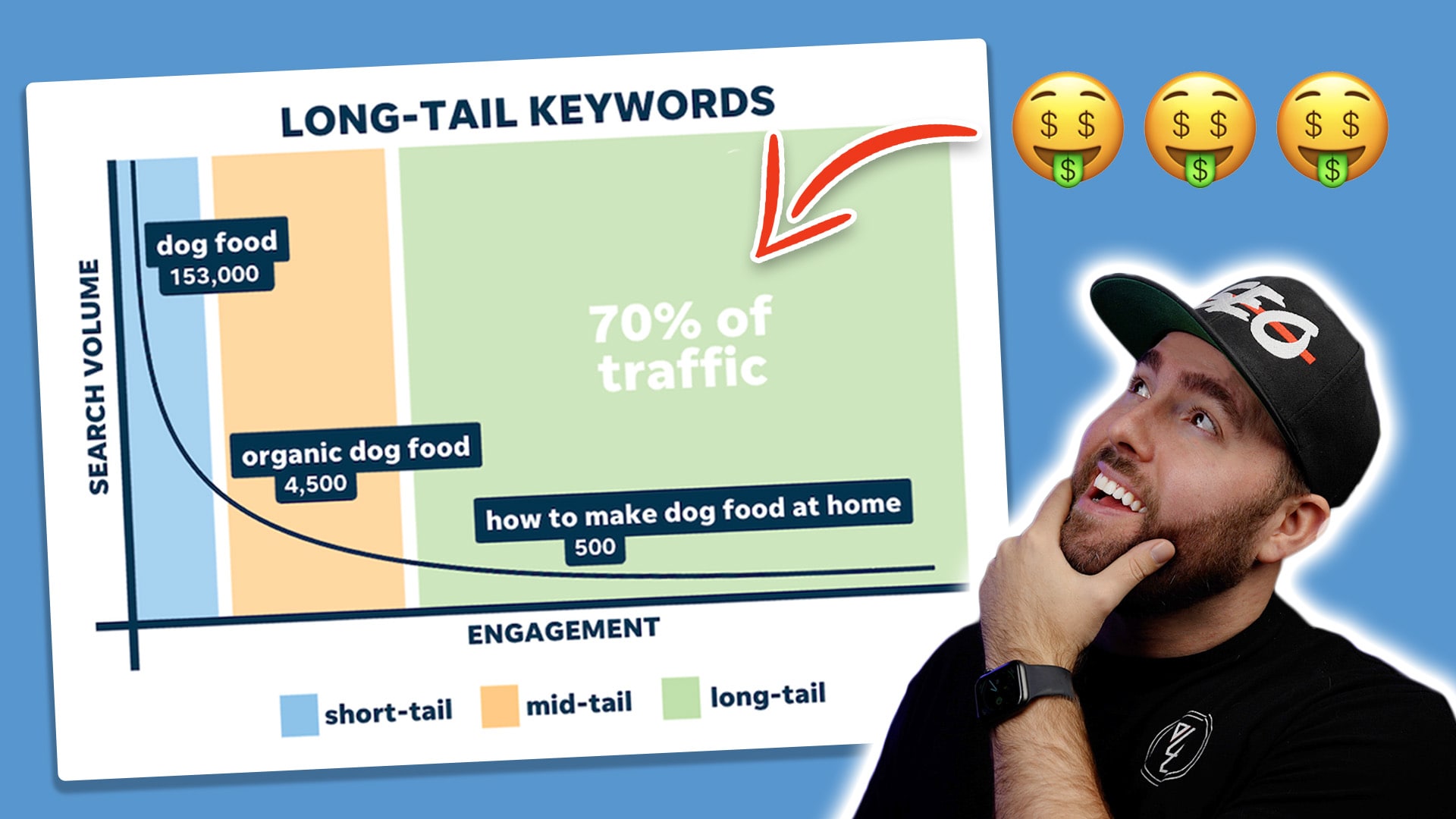You’ve probably heard that so-called long tail keywords are better to use as they’re easier to rank for. This is only partially true since there are two different types of long tail keywords, and only some convert better. Read on to learn everything you need to know about long tail keywords and how they can help you increase web traffic.
What Are Long Tail Keywords?
Long tail keywords are longer than regular keywords. Although they may only have a few searches per month, they usually have a higher conversion rate.
Here’s an example: “travel” is considered a head keyword that gets 450k searches every month. The phrase “best places to travel in the US with kids” is a long tail keyword as it gets only 30 monthly searches.
Why the Name “Long Tail” Keywords?
The name comes from the so-called search demand curve of keywords. If you listed all of Google’s monthly search queries by search volume, you’d get a curve that displayed a few keywords with very high search volumes at its head, and billions of keywords with very low monthly search volumes at its long tail.
According to data experts, there are about 31k keywords that have search volumes of over 100k monthly searches. However, there are 3.8 billion keywords with less than 10 monthly searches — these make up 95% of the keyword database in the US. In fact, 15% of daily searches performed on Google are completely new.
To be considered a long tail keyword, a query doesn’t have to get less than 10 monthly searches or contain a specific number of words. While many one-word keywords are searched less than 100 times per month, some five-word keywords have up to thousands of searches every month.
In short: it’s not the length of a keyword that qualifies it as being long tail, it’s the search volume.
What Makes Long-Tail Keywords So Powerful?
Long tail keywords are an essential part of a strong SEO strategy. Here’s why:
1. They’re less competitive
Popular keywords with high search volumes often have a high keyword difficulty (KD) score and are very hard to rank for, especially if you have a new website. However, if you use a keyword with low monthly searches and a low KD score, you have a chance to rank in the top 10 search results, even if your website is new.
2. They’re easier to address
While general search queries require more details, specific ones only need to be answered briefly to satisfy a searcher. In other words, creating content around long tail keywords will be easier and require less work.
In addition, you can check for groups of similar long tail search queries and simply create content on multiple pages with only a few differences. That means you can easily create several sites on the same day to address similar long-tail searches.
3. There are lots of them
Although you can’t expect super-strong website traffic from a single long tail keyword, using multiple over time will eventually result in substantial growth. What makes using long tail keywords a no-brainer is the fact that there are so many of them in any niche and industry, so you’ll always have lots to choose from.
How to Find Long Tail Keywords
There are many different ways to find long tail keywords — here are some examples with the dos and don’ts!
1. DON’T use Google Autosuggest
One method suggests you simply enter your target keyword into Google followed by a few letters and see what Google Autosuggest comes up with. Since Autosuggest is meant to provide quick access to popular search queries that have high monthly search volumes, it won’t help you find long tail keywords.
2. DO use a Keywords Explorer
A keyword research tool makes finding long tail keywords very easy. Simply insert any word in your niche and check the search volume tab to find hundreds, if not thousands of long tail keywords. If you have a completely new website without any authority yet, use the KD tab to find the least competitive keywords.
Another helpful function in your keywords explorer is the ‘Questions’ section. It may return some great long tail keywords in question form.
For example, if you searched for “best lemon press,” you’d see that this query gets 30 monthly searches. Tweaking it a bit more, you could come up with “best lemon press squeezer,” which gets 10 monthly searches and is therefore suitable as a long tail keyword.
You could also choose a related variation, such as “best lemon juicer,” then check the question to find a long tail keyword like “what is the best lemon juicer?” with 20 monthly searches, or something more unique, such as “why does lemon juice clean pennies the best?” with 10 monthly searches.
3. DO check which keywords your competitors are ranking for
Use your keywords explorer to snoop on your competitors and check what long-tail keywords bring traffic to their sites. Simply insert their domain, look at the organic keywords report and then find the long-tail keywords they’re ranking for.
4. DO look at Reddit, Quora, and niche forums
Online community forums can provide you with some ideas for questions people ask and topics they’re interested in. Take some of those insights and insert them into your keyword research tool to find out their monthly search volume, KD score, and whether they qualify as long tail keywords.
The Two Types of Long-Tail Keywords
Another thing to be aware of is the difference between the two types of long tail keywords — while some are unique and valuable, others are simply less popular variations of high-volume keywords.
Supporting Long-Tail Keywords
Google knows that people use different words or phrases to search for the same thing. That’s why it ranks the same websites for different keyword variations. In other words, if your website starts ranking for a popular keyword, Google will automatically rank it for all its long tail keyword variations and you won’t have to create different pages to address each one of them.
Your research keyword tool may indicate whether your long-tail keyword is part of a broader topic and if there are more popular variations of that query. Anytime you enter a query into the keywords explorer, it assesses the top-ranking website and searches it for a more popular related long tail keyword that it’s ranking for. This is called “Parent Topic.”
If you rank for that more popular keyword, you will automatically rank for its related long-tail keyword variations.
Topical Long-Tail Keywords
Whenever you find that the long tail keyword you’re analyzing in your keywords explorer is actually the parent topic, you can use a dedicated page to address it. As a result, you’ll automatically rank for all the variations of this popular supporting long-tail keyword.
However, sometimes it’s more complex than that. For example, if you were to analyze the keyword: “natural sleep aid for dogs,” you’d find that the parent topic is simply “sleep aid for dogs” with 1.6k monthly searches.
People who add the word “natural” are most likely looking for healthier non-pharmaceutical alternatives for their dogs to sleep better. That means, our long tail keyword is distinct from the parent topic.
A quick look at the top-ranking pages will tell you that the results entirely focus on general sleep aids for dogs, not natural ones. Therefore, it makes sense to create unique content on a dedicated page that addresses the long tail keyword “natural sleep aid for dogs.” In fact, you may even rank on the first page for it as there isn’t much competition in that niche.
Bottom line: don’t just trust what you see indicated as the most popular long tail keyword in the parent topic. While it can be helpful, it also has its limitations and flaws. Always check what the top-ranking pages for your search query of choice contain and then assess whether your keyword is part of a broader topic or can actually be distinct.
Final Thoughts
Using long-tail keywords should be an essential part of your SEO strategy to bring traffic to your site and grow your business. By using a keyword research tool and following the tips and tricks in this guide, you’ll soon build authority in your niche and rank higher on Google.

